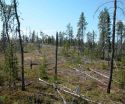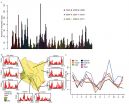(Press-News.org) This news release is available in Japanese.
In this special issue, the editors of Science invite experts to provide closer looks at how natural and human-induced environmental changes are affecting forests around the world, from the luscious, diverse forests of the tropics, to the pristine, resilient boreal forests of the north. The special issue is complemented by a package from Science's news department.
Amid extreme environmental and climate changes, Susan Trumbore and colleagues highlight the urgency of monitoring forest health, especially considering humans' high dependence on these biomes, which drive biodiversity, regulate the carbon cycle, and provide numerous resources; however, many factors that make up forest health are intricately at play and not always easily identifiable. For example, a large forest fire may have been ignited by human activity, but its intensity could reflect drought conditions. Teasing apart the various forest health indicators and properly accounting for these in models is of the upmost importance, Trumbore et al. conclude.
In a second Review, Sylvie Gauthier et al. discuss the traditionally resilient boreal forest, which now faces unprecedented rates of change and new threats - warmer temperatures could expand the range of pests and a drier climate could lead to extensive forest cover thinning, or loss. The authors suggest that sustainable management practices, such as adequate timber supply planning, are necessary to preserve the biodiversity of boreal forests, which currently act as a major carbon sink.
In another Review, Constance Millar and Nathan Stephenson analyze the increasingly prevalent combination of persistent drought and higher temperatures, which is pushing some temperate forests beyond thresholds of sustainability. While trees have withstood periods of drought for millennia, the authors note that recent increase in the occurrence of "hotter" droughts is testing trees' ability to survive new extremes. Forest fires, and "megafires" in particular, are a major concern, and could cause severe transformation of the temperate forests of today. The authors suggest that advanced identification of vulnerable forests and effective management intervention could ease the transition to new and better-adapted forest states.
A fourth Review by Simon Lewis and colleagues looks at the impact of humans on tropical forests, which play a critical role in regulating the global climate through water transpiration, cloud formation, and atmospheric circulation. Extensive logging has left fragmented areas of tropical forest, disrupting population dynamics and driving a subsequent decline in species. The authors highlight several examples of how humans have triggered a cascade effect of extinction in tropical forests, particularly if species that disperse seeds are affected. This severe degradation of tropical forests will continue, unless new "development without destruction" pathways are established, the authors say. Finally, a Review by Michael Wingfield et al. examines the particular susceptibility of plantation forests, given their uniform nature, to pathogens and insect pests. Globalization is compounding this issue, and while there are some solutions, especially through genetic engineering, to protect these forests, the authors cite lack of investment, capacity, and coordination of efforts at a global level as barriers.
A collection of news pieces bring these issues to life, highlighting forest health problems that are currently afflicting trees around the world. A piece by Gabriel Popkins tells the story of the eastern hemlocks of North America, which have mostly been reduced to leafless gray skeletons by the hemlock woolly adelgid (Adelges tsugae); left unchecked, this insect kills nearly every hemlock tree it attacks - but intense efforts in combination with science have spared a few trees from this fate. Another article by Tim Appenzeller looks at how boreal forests are - or are not - recovering in terms of biodiversity following megafires, such as the one that hit Canada's Northwest Territories last year, which are becoming increasing prevalent. A third news feature, by Elizabeth Pennisi, follows prominent forest ecologist Robin Chazdon, who has spent decades studying the difference between planted forests and natural recovery, and is now focusing at the policy level to try and reshape the way we approach reforestation.
In a Policy Forum that looks for answers to improve forest health, Steven Struass et al. discuss the benefits of genetically engineered trees to counteract pests compared to the slower, traditional crossing of seeds. The authors call for a better regulatory approach that would enable agencies to fast-track or exempt field research with a genetically modified product in given scenarios. An editorial by Ariel Lugo argues that foresters and ecologists must share the responsibility of forest research and conservation with other professionals from the natural and social sciences, in order to achieve optimal forest health. Together, this collection on forest health highlights the importance and susceptibility of one of land's most crucial plants in the face of a changing climate.
INFORMATION:
Article #7: "Forest health and global change," by S. Trumbore; H. Hartmann at Max Planck Institute for Biogeochemistry in Jena, Germany; S. Trumbore at University of California, Irvine in Irvine, CA; P. Brando at Instituto de Pesquisa Ambiental da Amazônia in Belém, Brazil; P. Brando at Woods Hole Research Center in Falmouth, MA. END
This news release is available in Japanese.
Amid continued difficulties around assessing bioweapons threats, especially given limited empirical data, Crystal Boddie and colleagues took another route to gauge their danger: the collective judgment of multiple experts. The experts' opinions on bioweapons-related risks were quite diverse, the Policy Forum authors say, adding to the challenge around developing a regulatory system for legitimate dual use research. Boddie et al. explain how they employed a Delphi Method study to query the beliefs and opinions of 59 experts ...
An examination of the immune genes of the southern African Khoe-San people has revealed a completely new kind of mutation, according to researchers at the Stanford University School of Medicine. The gene variant likely contributes to healthier babies, although the variant can also lower resistance to disease.
The findings grew out of a long-term effort by Peter Parham, PhD, professor of structural biology and of microbiology and immunology, to understand how immune system genes make us reject organ transplants.
A paper detailing the findings will be published online ...
CORVALLIS, Ore. - Myriad regulations and certification requirements around the world are making it virtually impossible to use genetically engineered trees to combat catastrophic forest threats, according to a new policy analysis published this week in the journal Science.
In the United States, the time is ripe to consider regulatory changes, the authors say, because the federal government recently initiated an update of the overarching Coordinated Framework for the Regulation of Biotechnology, which governs use of genetic engineering.
North American forests are suffering ...
Are humans unsustainable 'super predators'?
Want to see what science now calls the world's "super predator"? Look in the mirror.
Research published today in the journal Science by a team led by Dr. Chris Darimont, the Hakai-Raincoast professor of geography at the University of Victoria, reveals new insight behind widespread wildlife extinctions, shrinking fish sizes and disruptions to global food chains.
"These are extreme outcomes that non-human predators seldom impose," Darimont's team writes in the article titled "The Unique Ecology of Human Predators."
"Our ...
Scientists have exposed a chink in the armour of disease-causing bugs, with a new discovery about a protein that controls bacterial defences.
Bacteria react to stressful situations - such as running out of nutrients, coming under attack from antibiotics or encountering a host body's immune system - with a range of defence mechanisms. These include constructing a resistant outer coat, growing defensive structures on their surface or producing enzymes that break down the DNA of an attacker.
The new research shows that a protein called sigma54 holds a bacterium's defences ...
WEST LAFAYETTE, Ind. -- Results of the XENON100 experiment are a bright spot in the search for dark matter.
The team of international scientists involved in the project demonstrated the sensitivity of their detector and recorded results that challenge several dark matter models and a longstanding claim of dark matter detection. Papers detailing the results will be published in upcoming issues of the journals Science and Physical Review Letters.
Dark matter is an abundant but unseen matter in the universe considered responsible for the gravitational force that keeps the ...
Scientists studying the 2009 A/H1N1 influenza pandemic have found that the inconsistent regional timing of pandemic waves in Mexico was the result of interactions between school breaks and regional variations in humidity.
The research published in PLOS Computational Biology, led by Dr. James Tamerius at the University of Iowa and Dr. Gerardo Chowell at Georgia State University, applied mathematical models to understand the social and environmental processes that generated two distinct pandemic outbreaks ("waves") in Mexico during the summer and fall of 2009.
The summer ...
Children who have been abused or exposed to other types of trauma typically experience more intense emotions than their peers, a byproduct of living in volatile, dangerous environments.
But what if those kids could regulate their emotions? Could that better help them cope with difficult situations? Would it impact how effective therapy might be for them?
A University of Washington-led team of researchers sought to address those questions by studying what happens in the brains of maltreated adolescents when they viewed emotional images, and then tried to control their ...
PRINCETON, N.J.--Tracking mobile phone data is often associated with privacy issues, but these vast datasets could be the key to understanding how infectious diseases are spread seasonally, according to a study published in the Proceedings of the National Academy of Sciences.
Princeton University and Harvard University researchers used anonymous mobile phone records for more than 15 million people to track the spread of rubella in Kenya and were able to quantitatively show for the first time that mobile phone data can predict seasonal disease patterns.
Harnessing ...
Glenview, Ill. (August 20, 2015)--The popularity of electronic cigarettes has steadily increased worldwide, but little is known about their effects on health. New research suggests that the single use of an electronic cigarette approximating the nicotine exposure of one tobacco cigarette reduces the sensitivity of the cough reflex.
The study tested 30 adult lifetime nonsmokers with no history of asthma or respiratory diseases and used cough tests to determine how e-cigarettes affect the cough reflex. Capsaicin, the pungent extract of red peppers, was used to induce a ...




